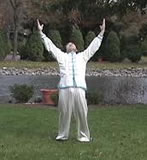Begin in the basic Crane stance with the hands at the waist. The legs are separated with a shoulder's width. Stretch the fingers open. Inhale as you lift both hands up the center of the body, fingers pointing forward, arms about 24" apart.
As the hands reach the neck begin to move both hands to the side, upwards, and backwards. Spread the arms as far apart as you can and to either side of the body as you lift both arms high above the head. Draw the arms up and back as you gently bend backwards.
At the same time as the arms are lifted up and back, try to lift both heels off the ground, and come up on your toes. Look up at the sky with your head drawn back.
As you begin to exhale, gently draw the arms forward and down, straighten the back, look forward, and move the arms down to the waist.
Repeat for 4 to 8 repetitions in a gentle, slow, calm, deliberate, and smooth manner.
This movement is found in the Wild Goose Qigong (Dayan Chi Kung) routine. Refer to "Wild Goose Qigong" by Hong-Chao Zhang, pp.20-21.
Back-bending while standing with the arms lifted above the head and with the hands touching is a commonly used hatha yoga posture called Anyvittasana.
This exercise is a hyperextension of the back, stretching of the latissimus dorsi muscles of sides of the upper back, a stretching of the upper rectus abdominis, engaging the pectoralis major, and a tensing of the trapezius muscles in the upper back and neck.
This movement opens and fills with Qi (Chi, Energy) the Middle Dan Tien (i.e., 中丹田, Zhong Dantian, middle elixir fields, cauldron) of the esoteric body system explained in Chinese Qigong (Yoga); or, analogously, opens the Heart Chakra (Anhata) of Hatha Yoga. Exercise of this area in the front of the body helps heal disturbed emotions, calms the spirit, strengthens the heart and lungs, and opens the Heart-Soul to the grace of light energy.
The wide-spread arms held up high help establish a feeling of opening up, freeing oneself, and uplifting one's mood and spirit.
You often see this ritual body posture in Christian revival meetings as a kind of "Saying Hallelujah" posture.
If the movement was done forcefully and with power and quickly it would be the flapping of the wings of a powerful bird like a Crane or wild Goose or for a human bodybuilder the performance of incline dumbbell flys.


Crane Frolic Qigong Exercise Set
Eight Animals Frolics Mind/Body Fitness Practices (Chi Kung) by Mike Garofalo
The webpages for the eight specific animals will also have photographs of me or others doing these exercises. There are also five, eight or twelve animals in Shaolin Kung Fu, Ba Gua Zhang, Taijiquan, and Xing Yi Quan. Movements or postures called a "crane" or "hawk" or "rooster" are found in most of these mind-body internal arts.
Chinese exercises recommended for improving fitness, maintaining good health, overcoming diseases, increasing energy and vitality, contributing to good mental health, and improving one's chances for longevity have a very long documented history going back to as early as 160 BCE in the Daoyin Tu.
No comments:
Post a Comment